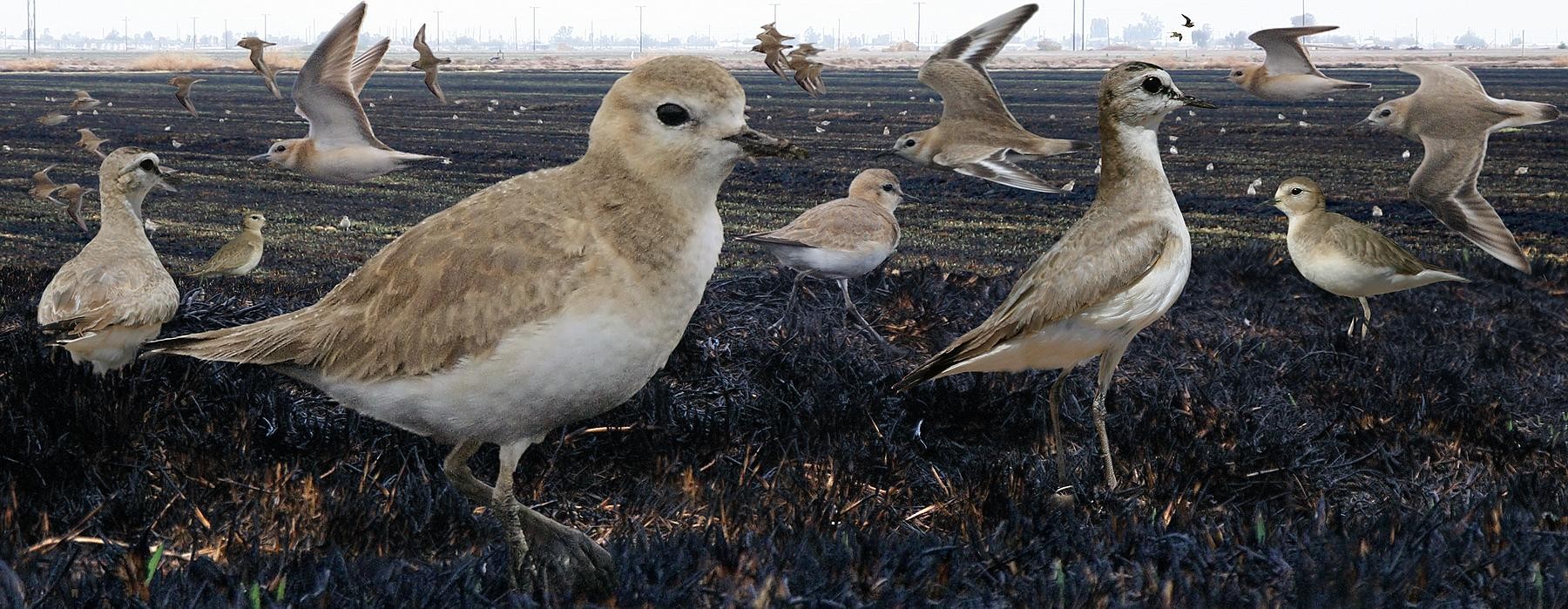Mountain Plover
A species of Typical plovers Scientific name : Charadrius montanus Genus : Typical plovers
Mountain Plover, A species of Typical plovers
Botanical name: Charadrius montanus
Genus: Typical plovers
Content
Description People often ask General Info
 Photo By Richard Crossley , used under CC-BY-SA-3.0 /Cropped and compressed from original
Photo By Richard Crossley , used under CC-BY-SA-3.0 /Cropped and compressed from original Description
The word plover came from a Latin word pluvia which means "rain". In Medieval England some migratory birds became known as plovers because they returned to their breeding grounds each spring with rain. In 1832 American naturalist John Kirk Townsend spotted a species of unknown bird near the Rocky Mountains, and assumed that all these birds live in mountains. The plover comes back each spring to its breeding grounds, and so the wrong name mountain plover was given to the species. The mountain plover is 8 to 9.5 inches (20 to 24 cm) long and weighs about 3.7 ounces (105 grams). Its wingspread is 17.5 to 19.5 inches (44.5 to 49.5 cm). The mountain plover's call consists of a low, variable whistle. Both sexes are of the same size. In appearance it is typical of Charadrius plovers, except that unlike most, it has no band across the breast. The upperparts are sandy brown and the underparts and face are whitish. There are black feathers on the forecrown and a black stripe from each eye to the bill (the stripe is brown and may be indistinct in winter); otherwise the plumage is plain. The mountain plover is much quieter than its relative the killdeer. Its calls are variable, often low-pitched trilled or gurgling whistles. In courtship it makes a sound much like a far-off cow mooing. 
Size
20-25 cm (8-10 in)
Life Expectancy
10 years
Nest Placement
Ground
Clutch Size
1 - 4 eggs
Feeding Habits
Mountain Plover primarily consume insects, notably grasshoppers, crickets, beetles, and ants, but also prey on scorpions, centipedes, and, infrequently, seeds. They exhibit a characteristic run-and-stop forage technique, rapidly advancing, pausing to scan, and then pouncing on detected prey. Mountain Plover adapt their behavior to inspect ground irregularities or use tail pumping and foot trembling to disturb and capture hidden insects.
Habitat
Mountain Plover thrive in semi-arid plains, grasslands, and plateaus that feature shortgrass prairies at elevations ranging from 2,100 to 10,663 feet. They favor environments with sparse vegetation, including grassy semideserts with saltbush and sage, as well as human-altered landscapes like fallow fields. During migration and winter, they utilize various shortgrass habitats across broader regions.
Nest Behavior
Males of mountain Plover create several nest scrapes before females select one. Nesting includes the laying of eggs often camouflaged with biological materials. Parents exhibit extensive care, with specific egg and chick tending behaviors demonstrating highly evolved survival strategies.
Nest Characteristics
Mountain Plover's nests are shallow scrapes located on bare or nearly bare ground, including burned areas or fallow fields. They typically line them with lichen, grass, roots, leaves, and measure approximately 3.7 inches wide and 1 inch deep. Unique to mountain Plover is the partial covering of eggs with mammal droppings.
Dite type
Insectivorous
People often ask
General Info
Feeding Habits
Bird food type
Behavior
Mountain Plover exhibit a distinctive reproductive strategy upon arrival at their breeding grounds in early spring. Males establish territories through displays and the creation of scrapes as potential nesting sites. Their courtship rituals include bowing, fanning tails, making low calls, and engaging in 'butterfly' and 'falling leaf' flights. A unique aspect is that pairs typically use two separate nests, with the female dividing her clutch, commonly six eggs, between them. Mountain Plover show little fidelity to territories or partners in consecutive years. After the fledglings are independent by July, winter migration begins, although their exact movements during this period remain largely uncharted.
Distribution Area
It breeds in the high plains of North America from extreme southeastern Alberta and southwestern Saskatchewan to northern New Mexico and the Texas panhandle, as well as an isolated site in the Davis Mountains of West Texas. About 85 percent of the population winters in the San Joaquin and Imperial Valleys in California. Its winter range also extends along the U.S.-Mexican border, more extensively on the Mexican side. The mountain plover needs about 70 acres of territory for breeding, and about 25 acres for survival in non-breeding times. Around late July, mountain plovers leave their breeding range for a period of post-breeding wandering around the southern Great Plains. Little is known about their movements at this time, although they are regularly seen around Walsh, Colorado and on sod farms in central New Mexico. By early November, most move southward and westward to their wintering grounds. Spring migration is apparently direct and non-stop. 
Species Status
Not globally threatened.
Scientific Classification
Phylum
Chordates Class
Birds Order
Shorebirds Family
Plovers Genus
Typical plovers Species
Mountain Plover